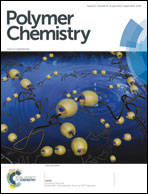N-Phthaloyltranexamic acid ammonium salt derivatives as photocaged superbase for redox free radical photopolymerization†
Abstract
N-Phthaloyltranexamic acid ammonium salt derivatives integrating with peroxides can invoke redox photopolymerization and propagating polymerization. A series of N-phthaloyltranexamic acid ammonium salt derivatives based on benzophenone, thioxanthen, and naphtha chromophores as novel photocaged bases were synthesized and characterized. In combination with a benzoyl peroxide initiator, these structures were able to initiate the amine-mediated redox photopolymerization of acrylates. In particular, the covalent binding of N-phthalimidoamino acid and type II chromophores (thioxanthone, benzophenone) improved remarkably the photoreactivity of photocaged bases (thioxanthen-DBU and benzophenone-DBU) compared to the parent compound. Furthermore, naphthal-DBU matches well the emission spectra of the mercury lamp with a dominant emission wavelength at 365 nm. More importantly, phthal-DBU & BPO as a new photocaged redox combination can invoke controlled redox polymerization within an irradiation time of 3 min. Finally, due to the persistent interaction of the produced longeval amine with peroxides, remarkable post conversion after irradiation, which is significant for preparation of photo-screened materials, was thus initially achieved in the redox photopolymerization.


 Please wait while we load your content...
Please wait while we load your content...